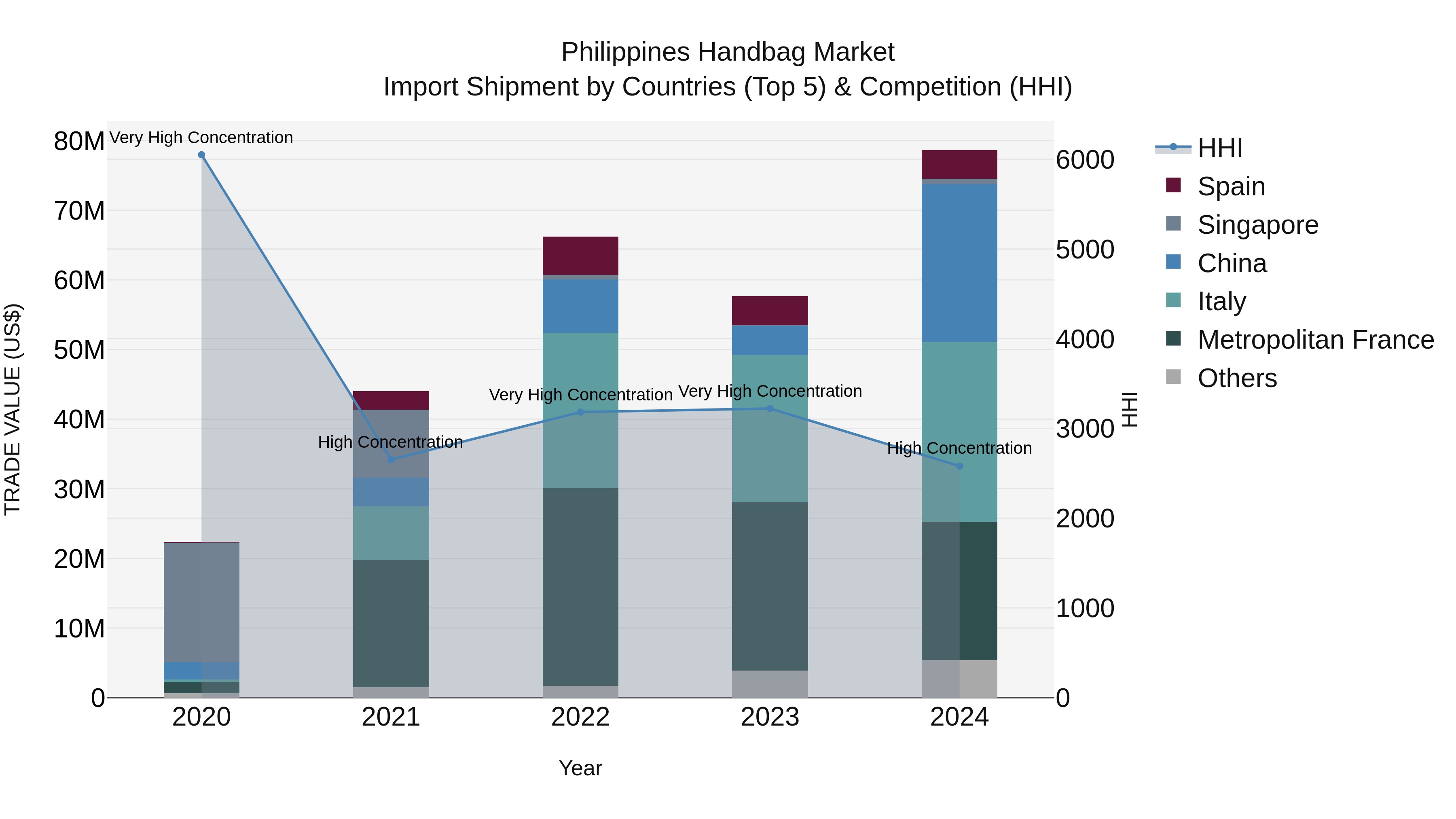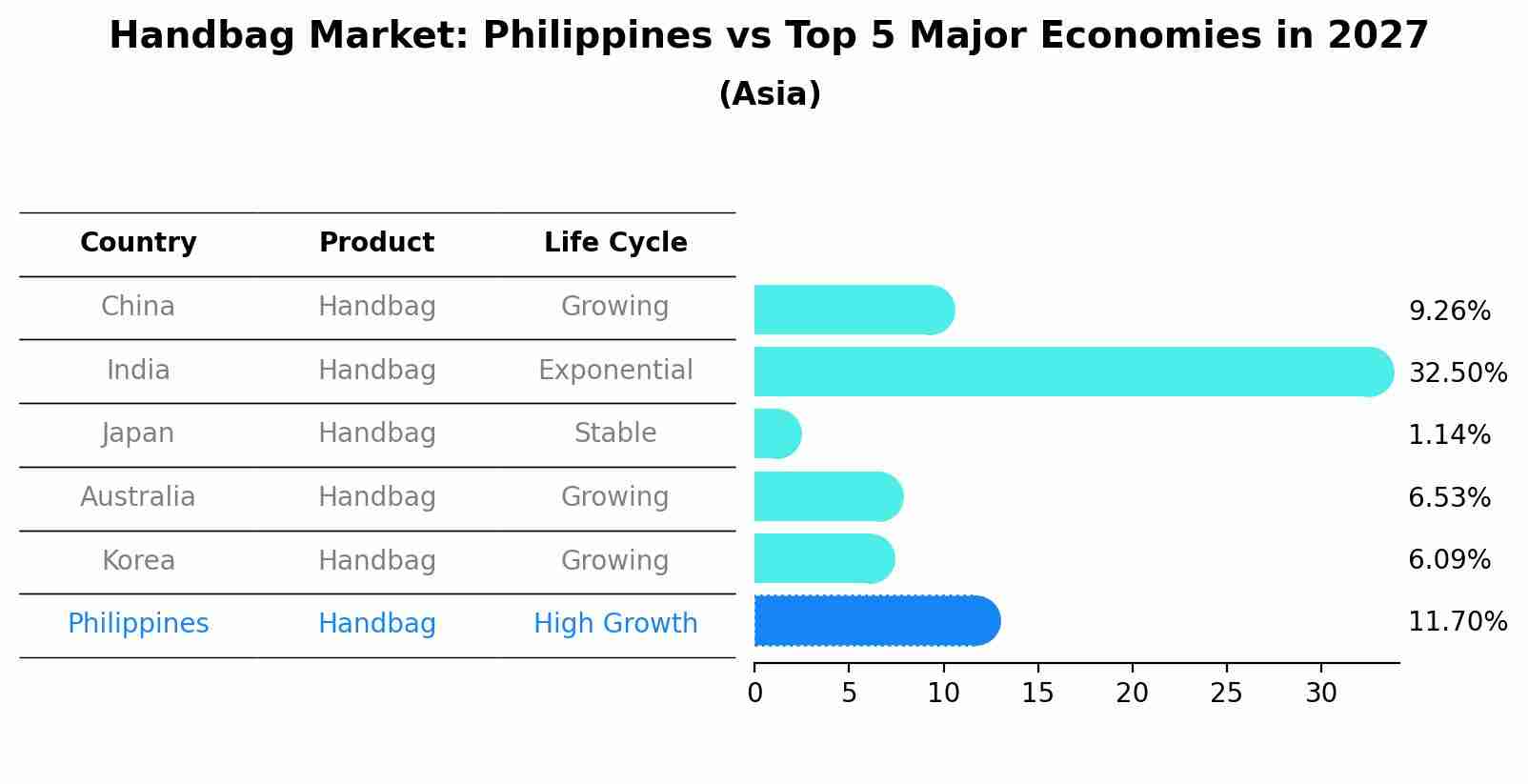Philippines Handbag Market (2025-2031) Outlook | Share, Forecast, Size, Growth, Value, Revenue, Industry, Analysis, Trends & Companies
| Product Code: ETC277769 | Publication Date: Aug 2022 | Updated Date: Nov 2025 | Product Type: Market Research Report | |
| Publisher: 6Wresearch | Author: Ravi Bhandari | No. of Pages: 75 | No. of Figures: 35 | No. of Tables: 20 |
Philippines Handbag Market Top 5 Importing Countries and Market Competition (HHI) Analysis
Philippines` handbag import market continues to thrive with significant growth in 2024. The top exporting countries - Italy, China, Metropolitan France, Spain, and Cambodia - have been key players driving this growth. The market concentration, while still high, has slightly decreased from 2023. The impressive compound annual growth rate of 36.97% from 2020 to 2024 highlights the increasing demand for handbags in the Philippines. Moreover, the growth rate of 36.31% in 2024 indicates a sustained momentum in the market, making it an attractive sector for further analysis and investment.

Handbag Market: Philippines vs Top 5 Major Economies in 2027 (Asia)
In the Asia region, the Handbag market in Philippines is projected to expand at a high growth rate of 11.70% by 2027. The largest economy is China, followed by India, Japan, Australia and South Korea.

Philippines Handbag Market Synopsis
The Philippines handbag market has experienced a consistent rise in demand driven by changing fashion trends and growing disposable incomes. The market overview indicates an annual growth rate of 6-8% over the past few years. Local and international brands are actively participating in the market, offering a wide range of handbag options. The market is expected to continue its upward trajectory, reaching an estimated value of $50 million by the next fiscal year.
Drivers of the Market
The Philippines handbag market is on a growth trajectory driven by various factors. A rising middle-class population with increased purchasing power is a key driver, as consumers aspire to own fashionable and functional accessories like handbags. The influence of social media and celebrity endorsements further boosts the demand for trendy handbags. Additionally, changing lifestyles and the need for bags suitable for various occasions, such as work, travel, and leisure, contribute to market growth. The availability of a wide range of handbag options across different price points also fuels market expansion.
Challenges of the Market
The Philippines handbag market has growth potential, driven by fashion-conscious consumers. However, competition from international brands and concerns about intellectual property rights can pose challenges to local manufacturers. Additionally, economic fluctuations and changing consumer preferences may impact demand. To thrive, domestic handbag manufacturers need to invest in unique designs, emphasize local craftsmanship, and explore ways to effectively market their products both domestically and internationally.
COVID-19 Impact on the Market
The Philippines handbag market had been growing steadily with fashion-conscious consumers. However, the pandemic brought about a decline in consumer spending and a shift in preferences towards more practical items. The handbag market faced challenges as luxury and high-end brands struggled to attract buyers. Recovery in this market hinges on economic recovery and the revival of fashion-conscious shopping habits. Brands may need to introduce innovative designs and adapt to changing consumer priorities to navigate the post-pandemic landscape successfully.
Key Players in the Market
The Philippines handbag market is witnessing growth as consumers focus on fashion and functionality. Local designers and brands like Aran?z and Rags2Riches are gaining popularity. Additionally, international brands like Coach and Michael Kors maintain a strong presence in the premium segment.
Key Highlights of the Report:
- Philippines Handbag Market Outlook
- Market Size of Philippines Handbag Market, 2024
- Forecast of Philippines Handbag Market, 2031
- Historical Data and Forecast of Philippines Handbag Revenues & Volume for the Period 2021-2031
- Philippines Handbag Market Trend Evolution
- Philippines Handbag Market Drivers and Challenges
- Philippines Handbag Price Trends
- Philippines Handbag Porter's Five Forces
- Philippines Handbag Industry Life Cycle
- Historical Data and Forecast of Philippines Handbag Market Revenues & Volume By Product Type for the Period 2021-2031
- Historical Data and Forecast of Philippines Handbag Market Revenues & Volume By Satchel for the Period 2021-2031
- Historical Data and Forecast of Philippines Handbag Market Revenues & Volume By Bucket Bag for the Period 2021-2031
- Historical Data and Forecast of Philippines Handbag Market Revenues & Volume By Clutch for the Period 2021-2031
- Historical Data and Forecast of Philippines Handbag Market Revenues & Volume By Tote Bag for the Period 2021-2031
- Historical Data and Forecast of Philippines Handbag Market Revenues & Volume By Other Product Types for the Period 2021-2031
- Historical Data and Forecast of Philippines Handbag Market Revenues & Volume By Distribution Channel for the Period 2021-2031
- Historical Data and Forecast of Philippines Handbag Market Revenues & Volume By Online Retail Stores for the Period 2021-2031
- Historical Data and Forecast of Philippines Handbag Market Revenues & Volume By Offline Retail Stores for the Period 2021-2031
- Philippines Handbag Import Export Trade Statistics
- Market Opportunity Assessment By Product Type
- Market Opportunity Assessment By Distribution Channel
- Philippines Handbag Top Companies Market Share
- Philippines Handbag Competitive Benchmarking By Technical and Operational Parameters
- Philippines Handbag Company Profiles
- Philippines Handbag Key Strategic Recommendations
Frequently Asked Questions About the Market Study (FAQs):
1 Executive Summary |
2 Introduction |
2.1 Key Highlights of the Report |
2.2 Report Description |
2.3 Market Scope & Segmentation |
2.4 Research Methodology |
2.5 Assumptions |
3 Philippines Handbag Market Overview |
3.1 Philippines Country Macro Economic Indicators |
3.2 Philippines Handbag Market Revenues & Volume, 2021 & 2031F |
3.3 Philippines Handbag Market - Industry Life Cycle |
3.4 Philippines Handbag Market - Porter's Five Forces |
3.5 Philippines Handbag Market Revenues & Volume Share, By Product Type, 2021 & 2031F |
3.6 Philippines Handbag Market Revenues & Volume Share, By Distribution Channel, 2021 & 2031F |
4 Philippines Handbag Market Dynamics |
4.1 Impact Analysis |
4.2 Market Drivers |
4.2.1 Increasing disposable income of consumers in the Philippines |
4.2.2 Growing fashion consciousness and awareness among the population |
4.2.3 Rising demand for eco-friendly and sustainable handbag options |
4.3 Market Restraints |
4.3.1 Competition from counterfeit products impacting market credibility |
4.3.2 Fluctuating raw material prices affecting production costs |
4.3.3 Economic uncertainties and fluctuations in consumer spending |
5 Philippines Handbag Market Trends |
6 Philippines Handbag Market, By Types |
6.1 Philippines Handbag Market, By Product Type |
6.1.1 Overview and Analysis |
6.1.2 Philippines Handbag Market Revenues & Volume, By Product Type, 2021-2031F |
6.1.3 Philippines Handbag Market Revenues & Volume, By Satchel, 2021-2031F |
6.1.4 Philippines Handbag Market Revenues & Volume, By Bucket Bag, 2021-2031F |
6.1.5 Philippines Handbag Market Revenues & Volume, By Clutch, 2021-2031F |
6.1.6 Philippines Handbag Market Revenues & Volume, By Tote Bag, 2021-2031F |
6.1.7 Philippines Handbag Market Revenues & Volume, By Other Product Types, 2021-2031F |
6.2 Philippines Handbag Market, By Distribution Channel |
6.2.1 Overview and Analysis |
6.2.2 Philippines Handbag Market Revenues & Volume, By Online Retail Stores, 2021-2031F |
6.2.3 Philippines Handbag Market Revenues & Volume, By Offline Retail Stores, 2021-2031F |
7 Philippines Handbag Market Import-Export Trade Statistics |
7.1 Philippines Handbag Market Export to Major Countries |
7.2 Philippines Handbag Market Imports from Major Countries |
8 Philippines Handbag Market Key Performance Indicators |
8.1 Percentage of consumers opting for locally-made handbags |
8.2 Number of new entrants in the sustainable handbag segment |
8.3 Growth in online sales of handbags in the Philippines |
9 Philippines Handbag Market - Opportunity Assessment |
9.1 Philippines Handbag Market Opportunity Assessment, By Product Type, 2021 & 2031F |
9.2 Philippines Handbag Market Opportunity Assessment, By Distribution Channel, 2021 & 2031F |
10 Philippines Handbag Market - Competitive Landscape |
10.1 Philippines Handbag Market Revenue Share, By Companies, 2024 |
10.2 Philippines Handbag Market Competitive Benchmarking, By Operating and Technical Parameters |
11 Company Profiles |
12 Recommendations |
13 Disclaimer |
- Single User License$ 1,995
- Department License$ 2,400
- Site License$ 3,120
- Global License$ 3,795
Search
Thought Leadership and Analyst Meet
Our Clients
Related Reports
- Canada Oil and Gas Market (2026-2032) | Share, Segmentation, Value, Industry, Trends, Forecast, Analysis, Size & Revenue, Growth, Competitive Landscape, Outlook, Companies
- Germany Breakfast Food Market (2026-2032) | Industry, Share, Growth, Size, Companies, Value, Analysis, Revenue, Trends, Forecast & Outlook
- Australia Briquette Market (2025-2031) | Growth, Size, Revenue, Forecast, Analysis, Trends, Value, Share, Industry & Companies
- Vietnam System Integrator Market (2025-2031) | Size, Companies, Analysis, Industry, Value, Forecast, Growth, Trends, Revenue & Share
- ASEAN and Thailand Brain Health Supplements Market (2025-2031) | Strategy, Consumer Insights, Analysis, Investment Trends, Opportunities, Growth, Size, Share, Industry, Revenue, Segments, Value, Segmentation, Supply, Forecast, Restraints, Outlook, Competition, Drivers, Trends, Demand, Pricing Analysis, Competitive, Strategic Insights, Companies, Challenges
- ASEAN Bearings Market (2025-2031) | Strategy, Consumer Insights, Analysis, Investment Trends, Opportunities, Growth, Size, Share, Industry, Revenue, Segments, Value, Segmentation, Supply, Forecast, Restraints, Outlook, Competition, Drivers, Trends, Demand, Pricing Analysis, Competitive, Strategic Insights, Companies, Challenges
- Europe Flooring Market (2025-2031) | Outlook, Share, Industry, Trends, Forecast, Companies, Revenue, Size, Analysis, Growth & Value
- Saudi Arabia Manlift Market (2025-2031) | Outlook, Size, Growth, Trends, Companies, Industry, Revenue, Value, Share, Forecast & Analysis
- Uganda Excavator, Crane, and Wheel Loaders Market (2025-2031) | Strategy, Consumer Insights, Analysis, Investment Trends, Opportunities, Growth, Size, Share, Industry, Revenue, Segments, Value, Segmentation, Supply, Forecast, Restraints, Outlook, Competition, Drivers, Trends, Demand, Pricing Analysis, Competitive, Strategic Insights, Companies, Challenges
- Rwanda Excavator, Crane, and Wheel Loaders Market (2025-2031) | Strategy, Consumer Insights, Analysis, Investment Trends, Opportunities, Growth, Size, Share, Industry, Revenue, Segments, Value, Segmentation, Supply, Forecast, Restraints, Outlook, Competition, Drivers, Trends, Demand, Pricing Analysis, Competitive, Strategic Insights, Companies, Challenges
Industry Events and Analyst Meet
Whitepaper
- Middle East & Africa Commercial Security Market Click here to view more.
- Middle East & Africa Fire Safety Systems & Equipment Market Click here to view more.
- GCC Drone Market Click here to view more.
- Middle East Lighting Fixture Market Click here to view more.
- GCC Physical & Perimeter Security Market Click here to view more.
6WResearch In News
- Doha a strategic location for EV manufacturing hub: IPA Qatar
- Demand for luxury TVs surging in the GCC, says Samsung
- Empowering Growth: The Thriving Journey of Bangladesh’s Cable Industry
- Demand for luxury TVs surging in the GCC, says Samsung
- Video call with a traditional healer? Once unthinkable, it’s now common in South Africa
- Intelligent Buildings To Smooth GCC’s Path To Net Zero


















